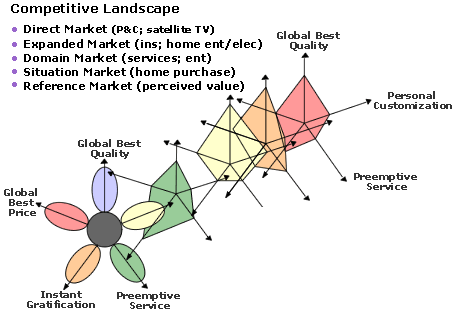| Lesson 13 | Competitive landscape for e-Business |
| Objective | Understand the competitive landscape and the inherent architectural drivers associated with it. |
Competitive Landscape for e-Business
As organizations formulate their e-Business strategies, they must understand the nature of the value proposition, the complexity of context, and the various roles that are functionally defined within the e-space. It is highly unlikely that all of the processes, roles, and context will be contained within a single organization. Alliance partners, ASPs, outsource providers, and joint venture partners are becoming the norm.
To identify and establish good working relationships with potential partners, an organization must have a framework within which to understand their unique capabilities and the capabilities of their potential partners. The following dimensions are perspectives on the market space in which the individual actors engage:
To identify and establish good working relationships with potential partners, an organization must have a framework within which to understand their unique capabilities and the capabilities of their potential partners. The following dimensions are perspectives on the market space in which the individual actors engage:

- Direct Market - The market tightly coupled to the specific product or service offered by the company, for example, Property and casualty insurance, Satellite TV
- Expanded Market - The general class of product and services offered by the company
- Domain Market - The life vale to the consumer. The domain market for insurance could be Financial Services; the domain market for Entertainment could be home electronics
- Situation Market - Complete product for life events/experiences. The situation market for financial services couid be a bank (mortgage for your home); the situation market for home electronics could be a TV
- Reference Market - Market of perceived value. Never existed before the web. The web has brought everyone into a common medium. Two interesting things come out of this; in any value discipline where I am attempting to create differentiation I am now competing against every other enterprise on the planet
It is critical to rate potential alliance partners to assess whether they are partnership material or competitor material. W need to rate them and understand them in multiple dimensions.
Online shopping as Rising Trend
The frequency of online purchases varies considerably by geography. Consumers in Asia, North America and Western Europe are most likely to shop online, while per capita online purchases in Eastern Europe and Russia, Latin America, and the Middle East and Africa are less frequent. Among the different age groups, Generation X consumers (born between 1966 and 1981) made more online purchases last year than any other age group, averaging nearly 19 transactions per year. Interestingly, despite the common belief that the upswing in online shopping is largely driven by the younger Millennials (born between 1982 and 2001), Generation X consumers in fact made 20 percent more purchases last year than their younger counterparts.
Stage of life and income levels are certainly primary factors driving both online and offline shopping, and Generation X consumers, many of which are more established in their careers and building homes
Competitive Landscape